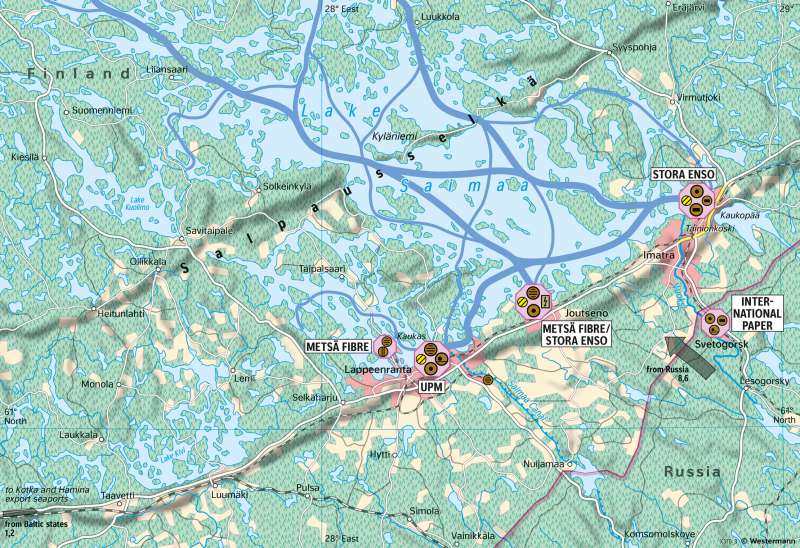Lake Saimaa (Finland) - Wood industry in the boreal forest
Resources
978-3-14-100890-6 | Page 79 | Ill. 3

Overview
The wood processing industry on the southern edge of the Finnish Lake District manufactures under ideal conditions: relatively short and low-cost routes for the transport of the necessary timber from large forests in the close vicinity, the import of timber from the Baltic States and Russia, the multistage processing of timber in integrated operating facilities, and short routes to the ports for export.
Branches of the wood processing industry
The wood processing industry is divided into a chemical and a mechanical branch. The chemical branch comprises the successive processing stages of pulp mill – chemical pulp mill – paper mill and cardboard factory, often in integrated plants. The mechanical branch comprises industrial sawmills and plywood factories, and sometimes also chipboard and fibreboard factories.
About 60 percent of the timber processed in the factories shown on the map is obtained from private forests in the region, supplemented by imports from Russia and the Baltic. Company-owned forests are only of significance in the districts of Lappenranta and Imatra. The proportion of coniferous wood (mainly pine) is between 40 and 100 percent, the rest consisting of birch which is mainly grown in Kaukopää. The following rule of thumb can be applied to convert the volume of timber to the resulting quantity of pulp production: 2 million cubic metres of timber generates 330,000 to 400,000 tons of pulp or paper.
The Finnish forest products industry
The Finnish forest products industry is characterised by a small number of major groups (on the map: Stora Enso, Oy Metsä Botnia AB and UPM-Kymmene) which, following a process of restructuring, have also been active for some years as global players on the international wood markets. Stora Enso and UPM are number two and three in Europe, seven and eight in the world, and both had sales of about 10.5 billion euro in 2018. The Metsä Group sales in 2018 was 5.7 billion euro. 74,000 people are employed in the forestry industry, which makes up 19% of exported goods. In Finland in 2018, some 10.5 million tons of paper and board were manufactured, most of which was exported. Like elsewhere paper production is decreasing, while paperboard production is rather stable.
In addition to paper, pulp (2018: 8.15 million tons), sawn wood (2018: 11,8 million cubic metres) and plywood (2007: 1.2 million cubic metres) are manufactured. In order to ensure competitiveness, as well as the internationalisation of production and sales, the emphasis is also placed on the development of new products, modern and efficient production processes and the sustainable use of natural resources (among other things through certification, reduction of emissions and water protection projects). First voluntary sustainability commitments of the forest industry in Finland were published in 2013, later renewed and now cover the period until 2025. 17 bullet points including all responsibility, ecological, financial and social dimensions summarise the commitments, guiding the whole forest industry sector to make even more sustainable choices.




